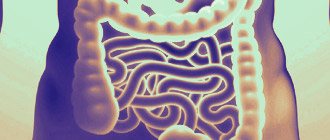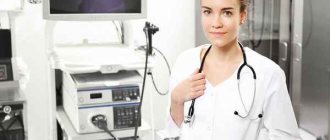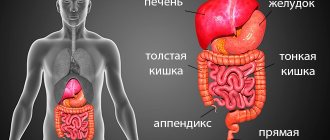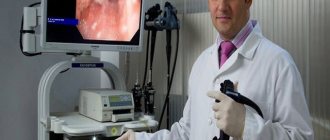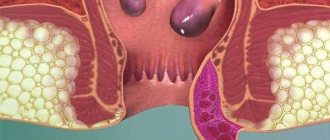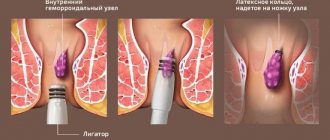According to doctors, colonoscopy for hemorrhoids is the most informative examination of the large intestine, and according to patient reviews, it is the most easily tolerated and painless. It can be completed both in private clinics and in public gastroenterological offices. The examination is carried out by a proctologist or diagnostician - coloproctologist.
Endoscopist
Colonoscopy is performed using a flexible endoscopic probe with a video chip - a colonoscope, which is connected to a special computer system. The procedure allows a specialist to carefully study the extent of the spread of the inflammatory hemorrhoidal process, screen for tumor tumors, immediately remove identified polyps or foreign objects, collect biological material for subsequent tests, and take photographs of problem areas.
The price of colonoscopy of the large intestine for hemorrhoids depends on the type of anesthesia and sedatives used, and the number of samples taken for the study. If desired, the patient can choose the conditions of the procedure - outpatient or hospitalized.
Colonoscopy - the essence and advantages of the method
Colonoscopy or fibrocolonoscopy is an invasive method of examining the intestinal tract using an endoscope inserted through the anal valve, which allows you to study the colon mucosa in detail, identify pathological processes, collect material and perform some therapeutic procedures.
This method has a number of advantages, namely:
- modern fiber colonoscopes, thanks to their optical system, can diagnose a tumor with a diameter of one millimeter, which is not possible with other endoscopic methods;
- high information content and reliability of the results, since the fiber colonoscope has high-quality optics and a lighting device, with the help of which a specialist can examine the smallest changes in the colon mucosa, in particular the initial stage of internal hemorrhoids;
- This method has a minimal number of contraindications, so it can be performed by almost all patients with hemorrhoids. In case of fear of the procedure or severe pain in the anus, the patient undergoes a colonoscopy under local or general anesthesia;
- the ability to perform therapeutic manipulations during the procedure, such as stopping bleeding, cauterizing nodes, eliminating rectal canal stenosis, removing polyps or small tumors, etc.;
- Colonoscopy can be used as an emergency when there is a need to quickly correct a problem such as intestinal obstruction, intestinal bleeding, etc.
These advantages of fibrocolonoscopy make it the main method for diagnosing intestinal diseases. But is a similar diagnostic procedure necessary for hemorrhoids?
For whom is a colonoscopy necessary and for whom is it prohibited?
An examination using modern colonoscopes will need to be performed if the proctologist suspects a pathology. Colonoscopy of the intestine for hemorrhoids allows the doctor to clearly see the whole picture of the disease and determine the appropriate treatment tactics.
Hemorrhoids
World statistics. Every 5th woman and 7th man under the age of 45 suffers from hemorrhoids, and with the elderly the figures approach 80%. That is why screening colonoscopy of the large intestine is recommended for all people over 50 years old once every 5 years.
It is necessary to tune in to undergo such a diagnostic procedure in the following cases:
- persistent abdominal pain, flatulence, constant alternation of constipation and diarrhea without a period of normalization of stool, detection of occult blood in stool tests;
- with persistent itching sensations in the anus;
- if pain occurs during bowel movements;
- if, during or without defecation, blood, spotting and/or mucus are released from the anus;
- before or after proctological surgery;
- with early detected but not removed polyps and other neoplasms;
- if there is a family history of colon cancer.
Is it possible to do a colonoscopy for hemorrhoids in 100% of cases? No, there are the following contraindications for this procedure:
- acute thrombosis of hemorrhoids, complicated paraproctitis, anal fissures;
- hemophilia and other blood clotting pathologies;
- adhesive, inflammatory or ulcerative processes in the gastrointestinal tract;
- cardiopulmonary failure;
- peritonitis.
Today there is an alternative to endoscopic colonoscopy - virtual colonoscopy of hemorrhoids using tomographic devices. However, this procedure also requires advance preparation and involves the insertion of a catheter to inflate the intestine. Compared to a “regular” colonoscopy, a virtual examination is more expensive, less informative, does not allow surgical interventions and, according to patients, is more likely to cause pain.
A doctor evaluates the results of a virtual colonoscopy
Quite often they ask the question: “Do pregnant women undergo colonoscopy for hemorrhoids?” No, any colonoscopy procedures during pregnancy are strictly prohibited.
Indications for the study
Indications for fibrocolonoscopy for hemorrhoids are the following situations:
- the need to clarify the diagnosis when other methods were uninformative;
- diagnosis of some complications of hemorrhoids;
- performing medical procedures (stopping bleeding, removing a polyp, cauterizing a node, etc.);
- choice of surgical treatment tactics;
- differential diagnosis of hemorrhoids and intestinal malignancy;
- biopsy for subsequent microbiological or histological examination.
Why and for what symptoms is the procedure prescribed?
The purpose of a colonoscopy is aimed primarily at studying the condition of the rectum and small intestine.
Also, the study is carried out not only in the presence of hemorrhoids, but also in colitis, Crohn's disease, if there are benign or malignant formations in the intestines . The technique allows you to obtain not only accurate information.
This method allows you to identify any pathologies even at the initial stages. Therefore, in most cases, a colonoscopy is performed to clarify the diagnosis or to detail the picture of a particular disease.
Our website provides the following useful information about hemorrhoids:
- Features of the internal course of the disease and external manifestations, and we will also tell you what causes bleeding in hemorrhoids;
- Detailed description of the various stages:
- first,
- second,
- third,
- fourth;
The following materials on proper nutrition are also presented:
- what you can and cannot eat if you have hemorrhoids;
- rules for building proper nutrition;
- approximate daily diet;
- diet for exacerbations of hemorrhoids;
- diet for hemorrhoids and rectal fissures.
A list of medications, suppositories and ointments that are used in the treatment of this disease can be found here.
Contraindications to this diagnostic method
As we have already said, fibrocolonoscopy is an unpleasant procedure because the endoscope is inserted into the intestines through the anal valve. In addition, there are contraindications under which this study will not be possible.
Thus, the following diseases or conditions are contraindications to fibrocolonoscopy:
- period of bearing a child;
- ulcerative nonspecific colitis in the acute stage;
- signs of inflammation of the peritoneum;
- carina of the anterior abdominal wall;
- colon diverticula;
- diseases that are accompanied by hyperthermic syndrome;
- food toxic infections;
- severe disruption of the cardiovascular system;
- respiratory failure;
- blood diseases with a violation of the coagulation system;
- tendency to seizures and epilepsy;
- mental illness;
- severe somatic condition of the patient.
Colonoscopy options
During the procedure, a device is inserted into the rectum through the anus, which passes through the entire large intestine, and in some cases it is possible to examine the small intestine. If the patient has prepared for the procedure, then on the monitor the doctor is able to see the condition of the intestines, mucous membranes, the elasticity of the walls and their structure. For better visibility, the intestines are expanded from the inside with air. During the examination, the doctor may take a biopsy and perform chromoscopy (staining with special dyes).
If we talk about the diagnostic and practical benefits of colonoscopy, this procedure can:
- help in removing a foreign object;
- identify oncological formations;
- detect intestinal tuberculosis;
- identify polyps;
- see ulcerative colitis;
- help with the diagnosis of Crohn's disease.
Colonoscopy helps identify polyps
Virtual colonoscopy – what is it?
Virtual colonoscopy is an alternative to the classic fibrocolonoscopy examination. This method allows you to study the condition of the intestines without inserting an endoscope into it.
Virtual colonoscopy is prescribed to those patients who have contraindications to classical colonoscopy.
The essence of this study is that the intestinal tract is visualized using a computed tomograph.
This diagnostic method is more accurate than endoscopic colonoscopy, but, unfortunately, not all patients can afford such a study, since it is carried out only in private clinics and is expensive - from 9 to 15 thousand rubles.
Reviews
Reviews about colonoscopy for hemorrhoids are mostly mixed. As for the sensations after the procedure, patients often complain of slight bloating of the intestines, as it is expanded with air. You shouldn’t push or somehow speed up its removal, everything will happen naturally and quickly.
Olga, 56 years old:
“It just so happened that the trip to the colonoscopy coincided with an exacerbation of hemorrhoids. The doctor suggested postponing the procedure at least for a while. The nodes were still internal, but I was worried whether this would make inspection difficult. According to the doctor, everything went well, and since I was under anesthesia, I didn’t feel anything. And what about unpleasant sensations, well, who doesn’t have them during treatment?”
Marina, 34 years old:
“I was prescribed a colonoscopy before surgery to remove an intestinal cyst, and in addition to this, the hemorrhoids worsened. The proctologist, in addition to the diet before the colonoscopy, prescribed pills and suppositories to relieve the exacerbation of hemorrhoids. The doctor asked in detail about my preparation for the colonoscopy, and by the fifth question I realized that the procedure was already underway. The doctor periodically pressed on my stomach, but I never felt unbearable pain, overall it was tolerable.”
Preparing for a colonoscopy for hemorrhoids
All patients scheduled for fibrocolonoscopy must undergo training, since the accuracy of the study results depends on the quality of preparation.
Preparation for fibrocolonoscopy has two directions: a slag-free diet and intestinal cleansing. Let's talk about this in more detail.
Diet features
72 hours before the study, patients are prescribed a diet based on the following principles:
- The patient’s menu should consist of easily digestible products - fermented milk products with a low fat content, crackers, lean meats, fish and poultry in boiled and mashed form, semolina porridge with water, non-rich broths;
- food should be consumed in small portions (no more than 200 grams) 5-6 times a day at regular intervals (2.5-3 hours);
- When preparing dishes, you should use only gentle heat treatment methods - boiling, stewing, steaming;
- foods that cause bloating are excluded from the patient's menu - white cabbage and other vegetables, peas, lentils, beans, black bread, fruits, nuts, radishes, radishes, mushrooms, whole milk, carbonated drinks;
- the diet should not include foods that cause constipation - jelly, bananas, persimmons, rice, semolina, fatty varieties of cape, fish and poultry, strong coffee and black tea;
- It is forbidden to eat food that irritates the colon mucosa - marinades, hot spices and seasonings, sorrel, smoked meats;
The last meal before the study should be no later than 12 hours. Moreover, for a meal it is better to take kefir or yogurt, vegetable salad or soup.
Colon cleansing
In the evening at 21-22 hours on the eve of the study, the patient must perform a cleansing enema, take a shower and put on clean underwear. Instead of an enema, you can use the laxative drug Fortrans or give a Normacol microenema.
In the morning before the study, if bowel cleansing is poor at home or in the clinic, the cleansing enema is repeated.
Preparation process
You need to prepare in advance for a colonoscopy. The activities performed before the procedure are aimed at cleansing the intestines.
There are two ways to prepare for a colonoscopy:
- Cleansing enemas;
- Cleansing with special preparations.
Cleansing with an enema begins one day before the study . The day before the colonoscopy, you should take 2-3 tablespoons of castor oil. In the evening, do two enemas with a two-hour interval.
The volume of each enema must be at least 1.5 liters. In the morning, both enemas must be repeated. The preparation is considered effective if clean water ultimately comes out.
When preparing medications, the medical drug Fortrans is used. This is a white powder, divided into sachets. Each sachet is diluted in one liter of water. On average, 3-4 liters of solution are prepared, depending on the patient’s weight (one sachet per 20 kg of weight).
The entire solution should be drunk in the evening before the colonoscopy. It is possible to divide the dose into two parts (in the evening and in the morning on the day of the procedure), but please note that the last dose of the drug must be taken no later than 4 hours before the study.
It is important to know that Fortrans is not prescribed to children under 15 years of age and to patients suffering from intestinal obstruction or heart failure.
https://youtu.be/xTT9zJGU9bo
Research technique
Fibercolonoscopy is carried out both in private and public medical clinics. This study does not require hospitalization and is therefore performed in an outpatient setting in an endoscopy room.
In case of severe pain in the anus, local anesthetics are used during fibrocolonoscopy, for example, Xylocaine gel, Emla cream, Lidocaine spray or Dicaine ointment.
In case of adhesive disease, the last stage of hemorrhoids and the patient’s age under ten years, the examination is carried out under general anesthesia.
In the room where the study will be carried out, the patient must remove clothes from the lower part of the body - trousers, skirt, tights, underwear and others, and then lie down on the couch on his left side, pressing his knees to his stomach.
When the patient takes the described body position, the endoscopist begins the procedure. To do this, he lubricates the fibrocolonoscope with Vaseline and inserts it carefully and slowly through the anal valve into the large intestine. After the fibercolonoscope is inside the intestine, air is pumped through the air duct to inflate the intestinal walls and improve visibility.
During the procedure, the colon mucosa is examined up to the ileocecal junction, the relief of the intestinal wall is studied, material is collected for research, and therapeutic manipulations are performed if necessary.
After the doctor has received enough information, he sucks out the air from the intestines and carefully removes the endoscope.
Fibercolonoscopy is most effective and comfortable if the patient listens to the specialist’s instructions.
After this study, the patient spends 1-2 hours in the clinic, after which he goes home. Also, after the procedure, it is necessary to take enterosorbents for 1-2 days, since there may still be air in the intestines, which will cause a feeling of discomfort in the abdomen.
Performing a colonoscopy
Coloscopy is performed by a coloproctologist and a nurse. The examination itself takes place in a room specially equipped for this purpose. The patient is asked to remove clothing below the waist, put on a medical gown and lie down on a prepared couch, taking a certain position (turn on your side and press your legs bent at the knees to your chest).
The patient must be given local anesthesia - a drug containing lidocaine (dicamine ointment or Luan gel). Sometimes freezing is used, which is administered intravenously. Under no circumstances agree to undergo the procedure without anesthesia. You may experience a painful shock.
To undergo the procedure, children under 12 years of age and patients with an unbalanced psyche are given general anesthesia, when the patient is completely immersed in sleep for the duration of the study, and he does not feel anything.
After the anesthesia has taken effect, the nurse inserts a special probe equipped with a small flashlight and camera into the patient's anus. The probe is advanced through the intestines by pumping air. The camera transmits an image of the intestines to a computer monitor. At this time, the doctor uses a special monitor to comprehensively examine the condition of the intestines and mucous membranes. Analyzing photographs and videos, he draws up his conclusion. The specialist sees on the screen even the slightest changes in the functioning of the intestines: cracks, foreign bodies, neoplasms, foci of inflammation. If necessary, he can transfer the received images and recording to the attending proctologist.
If the patient is under local anesthesia, he can observe the doctor’s actions and the images appearing on the screen.
The time of the examination depends on the quality of preliminary preparation. It is individual. On average, a colonoscopy examination of the intestines lasts from 15 to 45 minutes.
Complications of colonoscopy
During an endoscopic examination of the colon, the patient may experience pain and some discomfort caused by the advancement of the endoscope through physiological bends and narrowings of the intestinal tract. Such sensations are normal, therefore, before the study begins, the endoscopist warns the patient about this.
But in addition to pain and discomfort, complications may arise during and after the examination, namely:
- perforation of the intestinal wall;
- intestinal bleeding;
- infection and inflammation of the intestines;
- allergies to anesthetic and other medications used during the study.
Almost all of these complications are iatrogenic, that is, they arise due to the fault of the endoscopist or due to poor-quality equipment. Therefore, it is important to choose a clinic with a good reputation and an experienced, highly qualified specialist, because the safety of diagnosis depends on this.
Possible complications
The intestinal examination technique is therefore considered safe. After a colonoscopy, complications can arise only due to erroneous actions of the doctor who damaged the intestines during the examination. If a hole appears in the intestine, the contents enter the abdominal cavity. In this case, the patient feels severe pain and vomiting. Sometimes body temperature rises.
Measures to eliminate perforation are taken urgently; any delay can lead to serious consequences - even death.
More often, the patient feels flatulence, bloating and slight discomfort that quickly passes.
Can hemorrhoids get worse after a colonoscopy?
After a colonoscopy, hemorrhoids cannot worsen, since modern endoscopes are thin and flexible, and therefore cannot damage hemorrhoids. But, if outdated equipment is used or the procedures are carried out by an inexperienced specialist, then complications are quite possible, in particular damage to the mucous membrane of the internal cones, their inflammation and rectal bleeding.
Who is it prescribed to?
Indications for colonoscopy:
- Age over 55 years old,
- Familial forms of colorectal carcinoma up to 20 years of age,
- Blood in feces
- Rectal bleeding
- Suspicion of a malignant or benign tumor,
- Suspicion of chronic inflammatory bowel disease (CIBD),
- Suspicion of other diseases of various parts of the intestine,
- Severe diarrhea or diarrhea of unknown etiology,
- Constant pain in the abdominal area,
- Preventive monitoring after removal of cancerous or benign neoplasia.
How much does fibrocolonoscopy cost?
In public medical institutions, fibrocolonoscopy is performed free of charge.
In private clinics and proctology offices, this study is carried out for a fee. The cost of the procedure depends on the region of the country where the medical institution is located, the prestige of the clinic, and the qualifications of the specialist.
For example, in Moscow, fibrocolonoscopy will cost an average of 4800 rubles, and with anesthesia 9200 rubles. In other cities of Russia the cost of this service will be lower.
